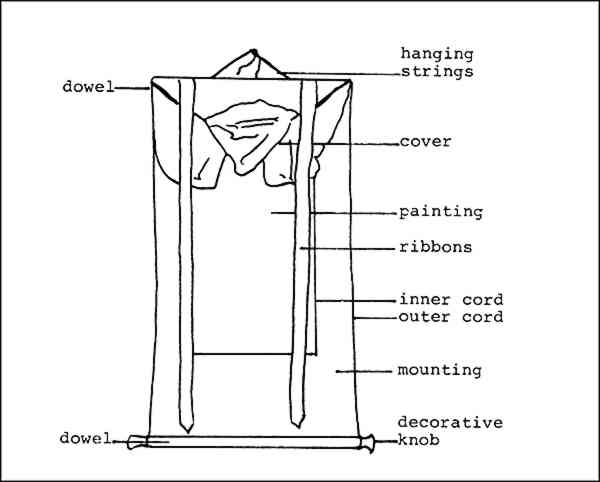NOTES ON THE TECHNIQUE OF TIBETAN THANGKASANN SHAFTEL
3 TYPES OF DAMAGETHE MOST COMMON forms of damage to thangka paintings are caused by their reactiveness to changes in relative humidity, water damage, improper handling, and deposits of grease and soot from butter lamps and incense smoke. 3.1 Water DamageThangkas often rested against walls of monasteries, causing a variety of recognizable damage to the supports, ground and paint layers. When the back linings became damp, and in thangkas where the back of the support was left exposed, cockling, staining, blurring of details and loss of color clarity were the result. Specifically, changes in relative humidity cause the support to cockle and wrinkle unevenly. The support is firmly sewn into a silk mounting which reacts differently than the cotton support to environmental changes. Large cockles often appear in the center of the support and along the sides, while tight wrinkles are often found in the four corners. Water damage is also caused, as mentioned above, by the use of water soluble adhesives to reline thangka picture panels. When the paintings are removed from their cloth mountings and relined onto paper or cloth supports with the use of water soluble adhesives, the water soluble yak-glue ground and subsequent paint layers sink into the support, and numerous paint layers blur into one another.
3.2 Improper HandlingImproper handling also causes great damage to these objects. The thangka form was devised to facilitate easy transportation; nevertheless, rolling and unrolling a painting over the centuries causes damage to the support, ground and paint layers. The traditional method of rolling a thangka is the only method considered to be respectful: the thangka is rolled from the bottom upwards, rolling the cover into the scroll. This compresses the pigment particles and abrades the surface. The crunchedup cover or, if there is no cover, the back of the mounting and the painting itself can severely abrade the surface. Improper rolling also damages the silk mountings, covers, and ribbons, causing them to crack along fold lines or warp out of shape. If the thangka is rolled by placing the hands on the painting panel instead of on the mounting, or if the thangka is carried with hands around the painting panel, then further damage can easily occur. Also, if the rolled thangka is stored lying flat, the support and ground can fold and crack, resulting in visible damage to the paint layers. This definition of improper handling may seem like a stern condemnation of the habits of the original owners, who were monks and lay worshippers; however, in this case, human-caused damage is not limited to the modern museum person. Damage to the paint layers may also show the effects of the artists' techniques, with interlayer cleavage or deep cracking, the exact nature of the damage often depending on the paint layer structure, as described above. 3.3 AccretionsTraditional Tibetan worship includes the burning of butter lamps and incense in front of thangkas. These deposit thick layers of darkening soot, grime and sometimes grease, which are extremely difficult to remove. Butter-lamp and incense smoke are also often imbedded in the silks causing deterioration. |
